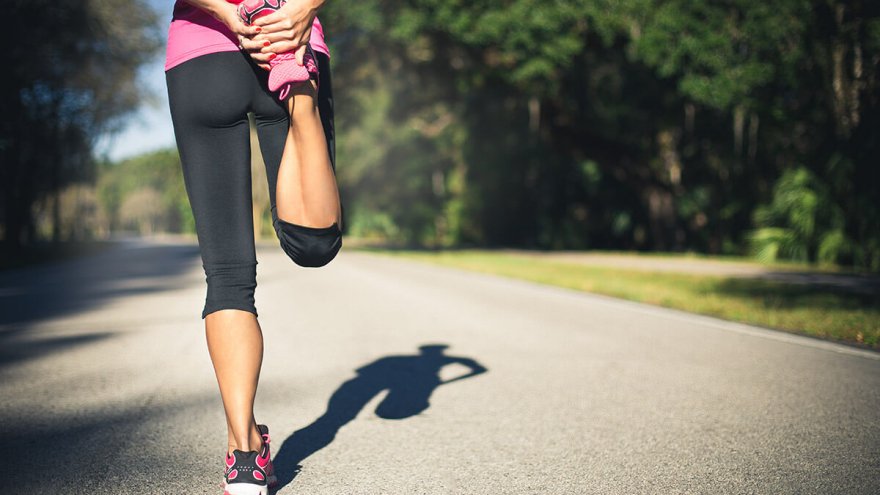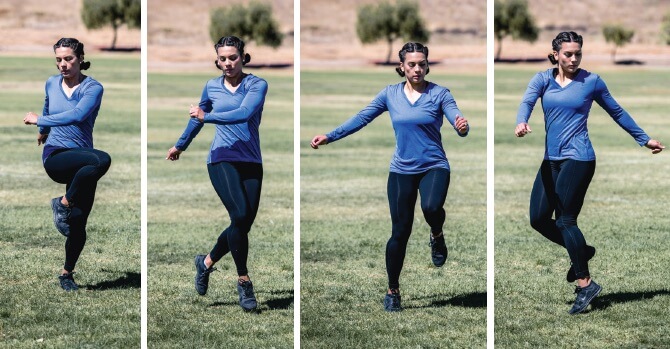The Best Leg Workout for Runners and Running

Most of us take the beautiful machine that is our body for granted. Think about it. When you stand with both feet squarely on the ground, the weight of your body is evenly distributed. What happens if you stand on one foot? Yup. It stands to reason that you are relying on one leg to support all of the weight in your body. Now think about how your body hits the ground with each footfall. Each foot impacts with a weight of anywhere from 2 1/2 to 3 times your body weight. Wait, what? With each stride, you take your body bears much more than the weight of your body with each impact. For this and many other reasons, working to strengthen your legs with a good leg workout for runners is super important.
How Do I Condition My Legs For Running?
There are many things you can do to help get (and keep) your body in the best possible condition to run and do it well! Just remember that strengthening your legs is more than weights.
The first thing you want to remember is how important it is to warm up your body before workouts. Often neglected by runners, the warm-up helps to adequately prepare your body for the stress you are about to put it through. An often-made mistake is to use static stretching when your body is cold. That is a no-no.
You should use dynamic stretching in order to get your body ready to roll and perform for you. There are many excellent drills to help you warm up. In addition to that, drills help you to run with an improved form which is helpful for injury prevention.
Some runners also skimp on the cool down which is another mistake. The obvious reasons are to prevent your blood pressure from dropping too quickly. Another point worth mention is slow movement post-workout is good for the muscles. Slow, easy movement helps you to prepare your body for the next day’s challenges.
Lastly, use a foam roller. This device helps work out the kinks.
Leg Workout For Runners
The first all-important exercise for runners are squats. In order to perform a quality squat, there are some things to keep in mind.
Standing with your feet shoulder-width apart, sit down on an imaginary chair by pushing your knees out and your butt back. Remember to keep your back straight and your shoulders and chest up while you do a squat.
Word to the wise: start with just a few and only use your bodyweight if you are new to squats. Even bodyweight squats will leave you struggling to move the next day!
Jump Squats are another excellent movement. Here, you take a normal squat and add a jump to the end. Focus on a point on the wall straight ahead of you to keep yourself balanced while doing jump squats.
Lunges are another essential exercise. You start by standing up tall with feet hip-width apart. As with any exercise, don’t forget to engage that core! Next, take a big step forward with one leg. Focus on landing on your heel. Lower your body until the thigh of the foot you have moved forward is parallel with the floor. Be careful not to lunge so far forward that your knee is beyond your toes. If you have done that, your foot is not in the proper position. Return to the neutral position and repeat.
Lunges can be done standing or in a walking lunge. You can do one leg at a time from one position, alternate legs from one spot or alternate legs while doing walking lunges.
Heel Raises are good for strengthening the Achilles and your calves. Standing stable (with your hand lightly resting on a nearby chair or wall for balance if necessary), just lift your heel up, hold for a brief moment and then lower. You can do heel raises on both legs to begin then switch to one-legged heel raises for an added challenge.
If you have access to a gym, seated leg presses are a great exercise. To do this properly, put your legs in the press about shoulder-width apart. Your bottom should stay stable on the seat and not raise or lift up with each effort. Your legs should form about a 90 degree angle as you press. Always remember not to lock your knees on either end of this movement as this common error results in injury.
Deadlifts are another awesome lift for those with weights at their disposal. Done with a standard bar with weights on either side, start with the barbell on the floor. Place your feet beneath the bar a bit more narrow than shoulder width apart with your toes pointed slightly out.
Grabbing the bar with an overhand grip, lift the bar to your thighs. Your arms should be straight as you make this motion.
Should I Do Leg Day If I Run?
Without a doubt, incorporating leg day is a good idea. Creating a leg workout for running is not hard and should not take you very long. If you commit yourself to leg day a couple of times each week you may find yourself sore while running at first.
Work your way through this. Strengthening those muscles is important and you are sure to see overall fitness gains.
Drills for Runners
Earlier in the article, we discussed the importance of incorporating drills into your workouts. There are drills ranging from high knees and butt kicks to Carioca.

These drills will help you warm up properly as well as increasing your speed and agility.
Can I Run After Leg Day?
Although you may have some muscle soreness, you absolutely can run after leg day. Many runners find that a nice and easy run after a session in the weight room actually helps them to work the kinks out. However, if you find yourself not feeling a run after leg day, there are many other things you can do.
Bicycling or swimming are two excellent cardio activities with zero or little impact. Running after leg day does not have to be painful!
Sources
Latest Articles
 Is Running on a Treadmill Easier Than Running Outside?Runners have their own preferences, whether it is treadmill running, running outside on the road, or exploring trails. So...
Is Running on a Treadmill Easier Than Running Outside?Runners have their own preferences, whether it is treadmill running, running outside on the road, or exploring trails. So... Is It OK to Use Trail Running Shoes on the Road?While trail running shoes can be used on roads, especially in situations where a runner encounters mixed terrains or pref...
Is It OK to Use Trail Running Shoes on the Road?While trail running shoes can be used on roads, especially in situations where a runner encounters mixed terrains or pref... How to Fix Sore Quads After Running?Rest, ice, gentle stretching, and over-the-counter pain relievers can help soothe sore quads after running. Also, ensure ...
How to Fix Sore Quads After Running?Rest, ice, gentle stretching, and over-the-counter pain relievers can help soothe sore quads after running. Also, ensure ... 10 Fruits With The Most Electrolytes to Replace Sports DrinksThese fruits are high in electrolytes such as potassium, magnesium, and calcium, essential for hydration, muscle function...
10 Fruits With The Most Electrolytes to Replace Sports DrinksThese fruits are high in electrolytes such as potassium, magnesium, and calcium, essential for hydration, muscle function...

